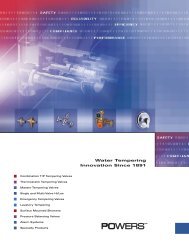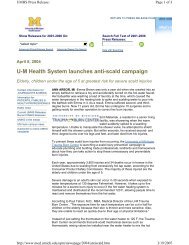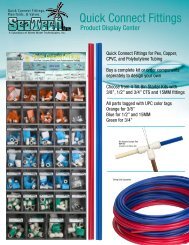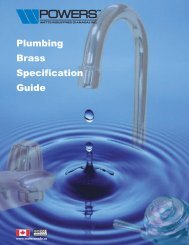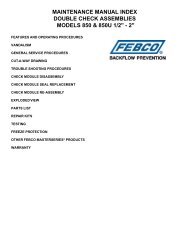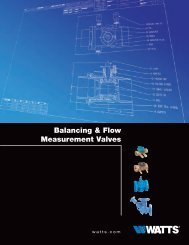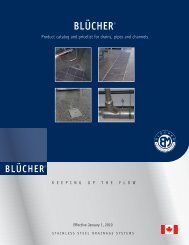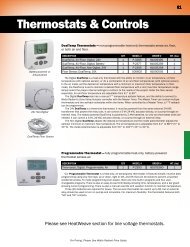TOO HOT? TOO COLD? Safe Bathing Temperatures - Seabridge ...
TOO HOT? TOO COLD? Safe Bathing Temperatures - Seabridge ...
TOO HOT? TOO COLD? Safe Bathing Temperatures - Seabridge ...
Create successful ePaper yourself
Turn your PDF publications into a flip-book with our unique Google optimized e-Paper software.
<strong>TOO</strong> <strong>HOT</strong>? <strong>TOO</strong> <strong>COLD</strong>?<br />
<strong>Safe</strong> <strong>Bathing</strong> <strong>Temperatures</strong><br />
Bruce Fathers on<br />
BATHING SAFETY FOR<br />
THE ELDERLY AND DISABLED
featurearticle<br />
BY<br />
BRUCE FATHERS<br />
<strong>Bathing</strong> safety for the elderly and disabled<br />
Can residents be protected from all hazards posed by bathing water? Technology’s answer<br />
I<br />
t’s a catch-22 for bathing operations<br />
in a nursing home: The demands of<br />
safer technology and risks of Legionella<br />
liability have stirred a trend toward<br />
institutional acceptance of the need to store<br />
hot water at 140°F or more and maintain<br />
water at 124°F or more in hot-water lines—<br />
temperatures that will neutralize or kill all<br />
bacteria. Yet those same higher temperatures<br />
pose the need to protect elderly residents<br />
from scalding injuries. Both risks—infection<br />
and scalding—can be life threatening.<br />
Scalding Risks<br />
A few years ago, an elderly man had a seizure<br />
while taking a shower at a nursing home.<br />
In his last moments of consciousness, he<br />
grabbed for the shower fixture’s handle as he<br />
fell, activating full-hot temperature. With<br />
no preset thermostatic valve for protection,<br />
scalding water poured down on him while<br />
he lay unconscious on the floor of the<br />
shower enclosure, his body blocking water<br />
from draining properly. He was found an<br />
hour later and, by that time, although the<br />
water heater’s supply had turned cold, the<br />
damage was done. He suffered permanently<br />
debilitating fourth-degree burns. Much of<br />
his skin, stripped off by the heat, required<br />
months of painful grafting to heal. Muscle<br />
tissue and bones were damaged, as well.<br />
Medical statistics reveal that scald burns<br />
caused by hot water flowing into a tub or<br />
shower enclosure are among the leading<br />
causes of severe burn injuries in the United<br />
States. According to the American Hospital<br />
Association, more than 112,000 people go<br />
to hospital emergency rooms each year for<br />
scald-related injuries. Children under the age<br />
of five, the elderly, and people with mental<br />
and physical disabilities are among the most<br />
susceptible. The elderly are also particularly<br />
susceptible to infection and are among those<br />
most vulnerable to Legionella exposure because<br />
of weaker immune defenses.<br />
Among older people, the threat of scalding<br />
attributed to pressure and temperature<br />
changes is dramatically increased because:<br />
• Older people lose the ability to respond<br />
quickly; the blunting of reflexes worsens<br />
with age.<br />
•With assistive bathing, temperature<br />
changes are not felt by the person controlling<br />
them.<br />
•Individuals receiving postsurgical or burn<br />
care have delicate, healing tissues and need<br />
carefully controlled bathing temperatures.<br />
•Bathers may be left unattended for extended<br />
periods of time, even though they are unable<br />
to change the water temperature.<br />
Figure 1. Water temperature risk levels.<br />
Another important factor to keep in mind<br />
is that most residents of long-term care facilities—either<br />
because they’re disabled or<br />
simply because they’re elderly—have delayed<br />
reactions to a sudden rise in water temperature.<br />
Therefore, residents can be subjected<br />
or can unknowingly subject themselves to<br />
the risk of severe tissue damage and burns<br />
(figure 1). At a water temperature of 130°F,<br />
only 20 seconds of exposure can produce a<br />
first-degree burn. Even momentary exposure<br />
to scalding water can result in second- or<br />
third-degree burns. At 135 to 140°F, it takes<br />
an elderly person only 5 to 6 seconds to sustain<br />
third-degree burns that can potentially<br />
destroy all skin layers. This can cause permanent<br />
injury and disfigurement and–depending<br />
on the level of exposure–possibly<br />
death. It’s not uncommon for scald-related<br />
injuries to require skin grafts and an average<br />
hospitalization of 17 days. Moreover, the<br />
many dangers of scalding water can expose<br />
your facility to numerous liabilities, lawsuits,<br />
bad publicity, and public ill will.<br />
Risk of Infection<br />
Recent studies have shown that water temperatures<br />
as high as 180°F within potable<br />
distribution systems cannot immediately<br />
kill “biofilm-insulated” bacteria on contact.<br />
(Biofilm forms when bacteria adhere<br />
to surfaces in aqueous environments and<br />
begin to excrete a slimy, glue-like substance<br />
that anchors them to the inner walls of<br />
plumbing pipes; a biofilm can be formed<br />
by a single bacterial species but more often<br />
consists of many species of bacteria, as well<br />
as fungi, algae, protozoa, debris, and corrosion<br />
products). Simply superheating and<br />
flushing water lines and fittingsperiodically<br />
will not necessarily ensure disinfection. Even<br />
at temperatures of 180°F or more, it takes<br />
time to pasteurize water within the pipes,<br />
and lower temperatures require even more<br />
time. At 151°F, Legionella bacteria die within<br />
two minutes; at 140°F, Legionella die within<br />
32 minutes; and at 131°F it takes five to<br />
six hours.<br />
Some facilities distribute hot water at<br />
temperatures as low as 120°F, and some<br />
even lower (e.g., 110°F), to eliminate any<br />
risk of scalding. Unfortunately, Legionella<br />
will grow in temperatures as high as 122°F,<br />
with an ideal growth range of 95 to 115°F<br />
(Figure 2).<br />
OSHA’s technical manual on Legionnaire’s<br />
Disease (section III, Chapter 7) states that<br />
water should not only be stored at a minimum<br />
of 140°F, but it should be “delivered<br />
at a minimum of 122°F to all outlets” to<br />
“minimize the growth of Legionella in a<br />
system.” The combination of 140°F water
featurearticle BATHING SAFETY FOR THE ELDERLY AND DISABLED<br />
Figure 2. Legionellae growth chart.<br />
with constant circulation (to prevent stagnation)<br />
and combination thermostatic/pressure<br />
balancing (Type T/P) valve technology is the<br />
only reliable way to kill bacteria and maintain<br />
sanitary potable water pipes.<br />
Further, the Centers for Disease Control<br />
and Prevention’s 2003 Guideline for Environmental<br />
Infection Control in Health-Care<br />
Facilities states, “Maintain hot water at the<br />
highest temperature allowed by state regulations<br />
or codes, preferably greater than 124°F”<br />
and “install preset thermostatic valves (Type<br />
T/P) in point-of-use fixtures (baths, showers<br />
and sinks) to help minimize the risk of<br />
scalding.”<br />
It is common knowledge that many<br />
facility managers have reduced thermostat<br />
settings for hot-water heaters<br />
in response to energyconservation<br />
concerns—a<br />
“welcome development”<br />
for Legionella bacteria.<br />
Moreover, the use of chlorine,<br />
even at the highest<br />
concentrations considered<br />
acceptable in plumbing<br />
systems, does not necessarily<br />
kill hardy bacteria<br />
like Legionella . And—most<br />
relevant to bathing/shower<br />
facilities—these bacteria<br />
are most dangerous when<br />
atomized, carried airborne<br />
with water, and transported<br />
into the lungs.<br />
institutions. In addition to adequate plumbing<br />
and proper plumbing maintenance,<br />
temperature-control devices can help to<br />
minimize the risks and liabilities.<br />
American Society of Sanitary Engineers<br />
(ASSE) performance standards that govern<br />
potable systems’ safety valves (see www.<br />
asse-plumbing.org ) are numbered 1016<br />
and 1017. ASSE 1017 applies to point-ofsource<br />
and distribution systems; ASSE<br />
1016 governs point-of-use or shower valves.<br />
ASSE 1016 recognizes three basic types of<br />
bath and shower valves (figure 3): those<br />
that compensate for pressure changes only,<br />
known as Type P; those that compensate for<br />
temperature changes and, to a lesser degree,<br />
pressure fluctuations (Type T); and those<br />
known as “combination valves,” or Type<br />
T/P, a hybrid of both pressure-balancing<br />
and thermostatic performance regulatory<br />
mechanisms.<br />
The pressure-balancing valve (Type<br />
P) is designed to adjust water temperature<br />
automatically by maintaining a mix of hot<br />
and cold water to within 3°F of the set<br />
point when pressure changes occur in the<br />
system. For instance, Type P valves provide<br />
an excellent way to compensate for pressure<br />
fluctuations within a plumbing system when<br />
a toilet is flushed or an appliance is turned<br />
on, but they cannot make adjustments for<br />
either sudden or gradual changes in supply<br />
temperature. If the hot-water supply line<br />
temperature unexpectedly increases to a<br />
dangerous level while inlet water pressure<br />
remains constant, the pressure-balancing<br />
valve will continue to pass the water, but at<br />
a dramatically increased temperature.<br />
Type P valves come with an adjustable limit<br />
stop that can be set to prevent handle rotation<br />
to the maximum hot-water position. The limit<br />
stop requires routine seasonal adjustment to<br />
accommodate for variations in seasonal temperature<br />
swings. This is especially important<br />
in regions where extreme weather conditions<br />
dramatically affect temperature from water<br />
sources such as lakes and rivers. The operational<br />
question is: How realistic is it to expect<br />
that maintenance will adjust these valves as<br />
required, two, three, or four times a year?<br />
Solutions<br />
Providing bather protection<br />
is a must for healthcare<br />
Figure 3. T/P technology minimizes risk of both bacteria growth and scalding.
BATHING SAFETY FOR THE ELDERLY AND DISABLED featurearticle<br />
Type T, or thermostatic mixing valves,<br />
compensate for both fluctuations intemperature<br />
and pressure (though to a lesser<br />
degree than Type P valves for pressure).<br />
Type T valves are designed to mix hot and<br />
cold water, delivering blended water at a<br />
constant, selected temperature, and feature<br />
an adjustable limit stop to prevent excessive<br />
handle rotation. The key advantage these<br />
devices have over Type P valves is that they<br />
have a temperature-sensing device. There’s<br />
no need to adjust the limit stop from season<br />
to season. The valve makes the temperature<br />
correction automatically to maintain the<br />
high limit set point.<br />
Combination valves, or Type T/P, offer<br />
the highest level of protection and are<br />
required to meet 1016’s most stringent<br />
performance requirements for adjusting<br />
to both temperature and pressure change.<br />
Type T/P valves must respond not only to<br />
temperature fluctuations as defined for a<br />
Type T valve, but must also meet the pressure<br />
change criteria of a Type P valve. Type<br />
T/P valves allow water to be generated and<br />
distributed at higher temperatures, but delivered<br />
at safe temperatures to the bather.<br />
It’s important to point out that Type T/P<br />
valves require no seasonal adjustment of the<br />
limit stop, sometimes saving maintenance<br />
personnel hundreds of hours of labor per<br />
year. Also, Type T/P valves provide redundant<br />
temperature protection in the event<br />
of a temperature-control failure upstream<br />
within the delivery system.<br />
Bruce Fathers is Marketing Director for Powers, a<br />
division of Watts Water Technologies, Inc., in Des<br />
Plaines, Illinois. He has spent 17 years in the water<br />
delivery and tempering industry. He has an MBA<br />
from DePaul University, Chicago, and a BS degree<br />
in marketing from Northern Illinois University. For<br />
further information, phone (800) 669-5430, x6207<br />
or visit www.powerscontrols.com.<br />
Conclusion<br />
Is the scalding-versus- Legionella dilemma<br />
a catch-22? Not at all. The potential for<br />
scalding can be minimized while, at the same<br />
time, the risk of bacteria growth is reduced.<br />
With a properly designed delivery system<br />
and a temperature/pressure-sensing shower<br />
valve (type T/P) at the point of use, both<br />
risks are virtually eliminated. Water can be<br />
distributed at higher temperatures, reducing<br />
the peril of Legionella , while the bather is<br />
protected from scalding with temperature/<br />
pressure sensing technology. With current<br />
technology, facilities no longer have to<br />
choose between possibly exposing residents<br />
to scalding or serious infection. ■<br />
Reprinted from NURSING HOMES/Long Term Care Management • September 2004 • Volume 53, Number 9




